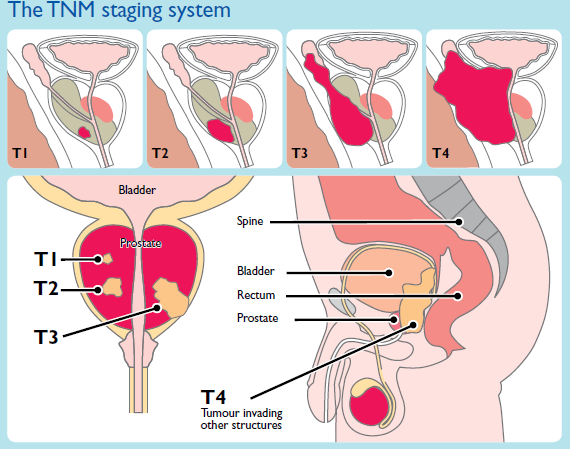Staging
This page explains staging for the most common type of prostate cancer. After initial diagnosis your medical team will want to ‘stage’ your prostate cancer. They will want to know whether it is just in the prostate (‘localised’) or whether it is in other areas of your body (‘non localised’).
Steps to Staging Prostate Cancer
Staging prostate cancer involves reviewing any scans such as an MRI or Bone Scan, PSA level and biospy results.
When the laboratory receives prostate biopsy results, the level of cancer in the tissue sample is graded. The system used to grade the sample is called Gleason Grading. This is explained in more detail here.
Men may need to have investigative scans: either an MRI scan, a bone scan, or both
MRI Scans
An MRI scan uses magnets to form pictures of the inside of the body. It can be used to see prostate cancer that has spread to the seminal vesicles or lymph nodes.
If men are claustrophobic, it may be possible to have an ‘open’ MRI or CT scan. However, this may not be available locally.
More information about how an MRI scan is performed can be found here.
Bone Scans
A bone scan will involve the injection of a radioactive dye into the body. It will take about four hours to circulate around the body and settle in the bones.
After this, a special camera will be used to take pictures of bones to see if they have been affected by prostate cancer.
Previous trauma, fractures and arthritis, will all show up on a bone scan and it may br difficult to identify areas which are cancerous. In these situations, further X-rays may be taken of a particular area.
Once all of the information from Gleason Grading and scans is available it will be possible to allocate a stage of prostate cancer.
The TNM system is used to classify prostate cancer:
- T stands for Tumour size,
- N stands for Lymph Nodes
- M stands for Metastases (spread of cancer to other organs or bones).
The following table explains the TNM stages. It can help to refer to the diagram underneath the table which shows the areas of the body being discussed.
| TNM Code | What it Means
|
|---|
| T | Stands for Tumour size. |
| T1 | The cancer is at an early stage and is not obvious on examination of your prostate, indicating localised prostate cancer. |
| T2 | Cancer can be felt on examination of your prostate on either one or both lobes of your prostate, again indicating localised prostate cancer. |
| T2a (T2 Subcategory) | Tumour involves half of a prostate lobe or less. |
| T2b (T2 Subcategory) | Tumour involves more than half of a prostate lobe, but not both lobes. |
| T2c (T2 Subcategory) | Tumour involves both lobes. |
| T3 | The cancer can be felt on the surface of your prostate which may indicate it has extended beyond the capsule of your prostate or to the surrounding seminal vesicles. |
| T3a (T3 Subcategory) | Cancer has spread to capsule of the prostate on one side of your prostate. |
| T3b (T3 Subcategory) | Cancer has spread to the capsule of the prostate on both sides. |
| T3c (T3 Subcategory) | Tumour has invaded seminal vesicle(s). |
| T4 | The cancer has spread beyond your prostate to the neck (beginning) of your bladder, your rectum (back passage) and is likely to have spread to other areas of your body. |
The human body is covered by a special type of drainage system called the lymphatic system. More information
| TNM Code | What it Means |
|---|
| N | Stands for Lymph Nodes. |
| NX | Lymph nodes not measured. |
| N0 | Lymph nodes do not contain cancer. |
| N1 | Lymph nodes contain cancer. |
Metastases refers to cancer that has spread to other areas of the body, such as other organs or bones.
| TNM Code | What it Means |
|---|
| M | Stands for Metastases (cancer which has spread to other areas of the body). |
| MX | Spread of cancer not measured. |
| M0 | No evidence of cancer spread to other areas of the body. |
| M1 | Clear evidence that cancer has spread to other areas of the body. |
Giving a grade to each of these three areas, T (tumour), N (lymph nodes) and M (metastastes) helps the medical team to plan the best treatment.
- Localised Prostate Cancer: This is cancer that is only in the prostate,
- Locally Advanced Prostate Cancer: This is cancer that is on the surface of the prostate gland and possibly affecting the seminal vesicles.
Treatment for both these levels of prostate cancer are explained in our Localised Prostate Cancer pages here.
- Metastatic Prostate Cancer (Non Localised): This is cancer that has spread outside of the prostate to other organs or bones.
Treatment for Metastatic Prostate Cancer is explained in our Non Localised Prostate Cancer pages here.
Thinking all of this through can be confusing and emotionally difficult. Our Orchid nurses are here to help. Contact us here.


